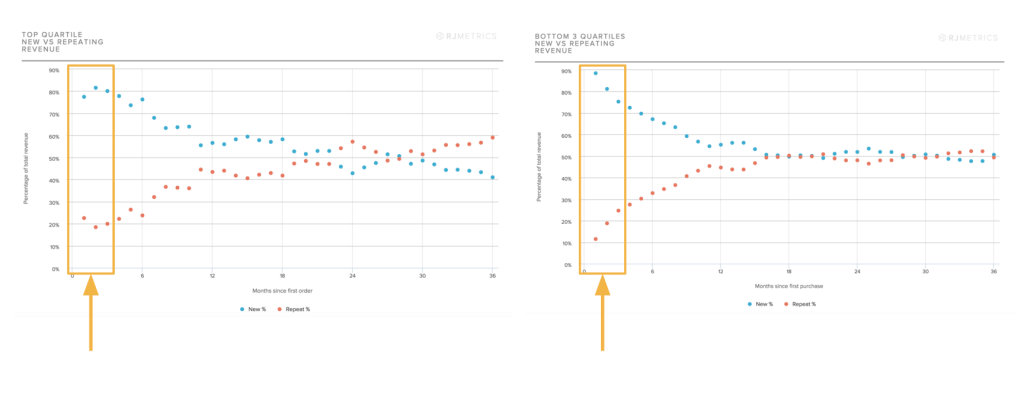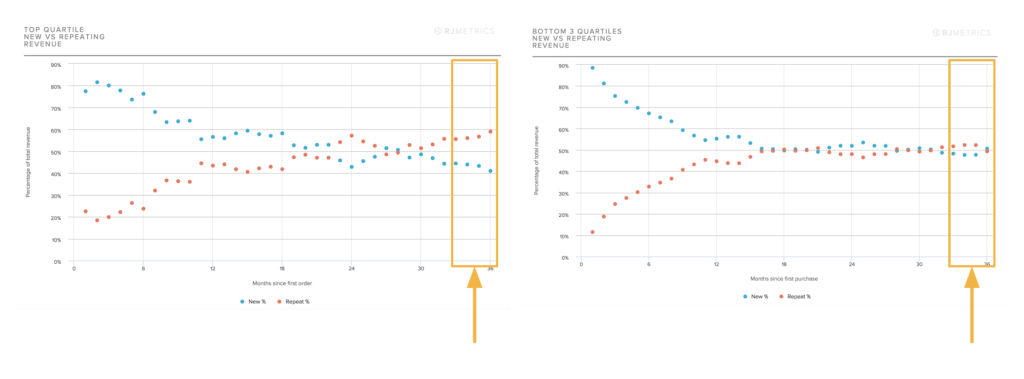Top performing companies get to $10 million in annual revenue within their second year of business. As for their counterparts? After year three they’re still falling short of that mark.
The point here isn’t to make you feel bad about the performance of your own company, getting to $10 million in annual revenue is difficult. But the exceptional performance of these companies does provide some important clues for how other companies can achieve similar growth patterns.
Based on research from multiple ecommerce benchmarks (Ecommerce Buyer Behavior, Ecommerce Growth) and the trends Shopify Plus’ Tommy Walker has seen from the hundreds of successful ecommerce companies he’s worked with, we’ve put together five questions that will get your business on the right path to $10 million in annual revenue.
1. How can I get in front of real people?
When we look at performance quartiles, we see that in month two, top performers are acquiring 3x the number of new customers as the next closest quartile.
A big part of this is likely the result of product/market fit, and that exponential growth out-of-the gate just isn’t the reality for 75% of ecommerce companies. But even if you don’t have lucky break of finding the perfect product with a large market, there are things any business can do to improve its chances of getting in front of the right market.
Tommy’s recommendation is to focus on building a pre-launch list. This pre-launch list means that when your store goes live, you already have a seed list of prospective buyers from the start. To start building this list, Tommy recommends the following tactics:
- Google search: Oftentimes the best answer is the most obvious; just search for companies and influencers who are in your new ecommerce space, or are selling things that are tangentially related.
- Facebook/Google Groups: Joining influencer groups early is a great way to not only spread the word about your new brand, but also to connect with the influential people in this group who are driving the conversation.
- Reddit: The front page of the Internet is a tough channel to take advantage of. However, if you take an influential blog within your vertical, and add it to the end of this URL: (we’ll use RJMetrics in this example) reddit.com/domain/rjmetrics.com, you’ll get a list of all the different subreddits that have shared content from RJMetrics. If you dig into that information, you’ll see the real conversations happening around your vertical, and get an extremely valuable view into your market.
2. How can I get them to purchase from me again as quickly as possible?
Repeat purchase revenue is also a major indicator of a company’s health. Already in month 1, top-performing companies are getting more than 20% of their revenue from repeat customers, while the rest start out with 10%.

Additionally, at year three, top-performers get as much as 60% of their revenue from return customers.

Getting this second purchase, however is extremely difficult. 68% of customers will never purchase a second time.
Tommy’s recommendation is to build your retention plan around two core strategies:
- Email marketing: This means using up-selling, cross-selling, flash sales, or any other targeted messaging to encourage a second purchase.
- Gathering customer feedback: You can use your existing customer base to give you the information about how to get repeat purchases. Ask questions like “Was I your first choice?” or “What almost made you not buy?” Answers to these questions will help you build top of funnel strategies and help you focus your offering moving forward.
3. How do I get that customer to purchase a third, and fourth time?
The good news is that once you got that second purchase, things get easier. While only 32% of first purchases will make a second purchase, 53% of customers that make a second purchase will make a third. And with each successive purchase, the likelihood of them coming back increases.
While, they may be easier to achieve, the strategies for getting these purchases differ slightly from the aggressive and prompt campaigns you’d use to get a second purchase:
- Loyalty programs: Specifically, make it a point to build your loyalty program around the core of people that really love your product. Some customers just won’t ever purchase again, and that’s ok, design your loyalty program for the customers that are actually loyal.
- Events: Hosting events and actually getting out into the community can be a huge win for your business. Chubbies does this extremely well (check out their events board on Pinterest). What they’ve found is that people who show up to their events turn into high lifetime value customers.
4. How can I leverage my most loyal customers?
Beyond the 4th purchase, you’re in the long-tail of customers. You won’t have a ton of these customers, but they represent an enormous amount of value. The top 10% of ecommerce customers are worth 6x the industry average, and the top 1% is worth 18x more.
These customers have obvious monetary value, but they’re also valuable as a unique acquisition channel:
- Refer a friend programs: Using these and other incentivized offers can be a huge help in not only getting new customers in the door, but giving current customers the opportunity to further engage with your brand. You always want to make sure you’re making it as easy as possible to share your products and refer your brand.
- Asking for feedback: Find out what these VIP customers love most about your brand. Use surveys and feedback forms, but don’t be afraid to get on the phone with these people either! These customers love you, find out why.
5. What are more advanced growth strategies I should be thinking about?
Once your business is acquiring customers, retaining them, and building out a core group of loyal customers, it’s time to think about some more advanced strategies. The pace to $1 million is rapid, but when you get to the higher revenue milestones you should expect your growth rate to slow.
To continue pushing towards your revenue goals, you’ll need to try more advanced strategies–like social selling–spend time on optimizations–like checkout experience tweaks–and possibly expand your offering. Nasty Gal, Bonobos, and Chubbies have all tapped into new growth by expanding their limited initial offering of vintage clothes, pants, and shorts respectively, to producing more lines of clothes and a much broader offering. Keep in mind, this type of expansion works best when you have that core group of VIP customers that already loves you.
Keep learning
If you’d like to explore these questions further, check out our recent webinar on the topic. Tommy Walker and RJMetrics’ Anita Andrews dig deep into these five questions and how to use data to answer them. You can watch the full webinar video below, or check out the slides here.

